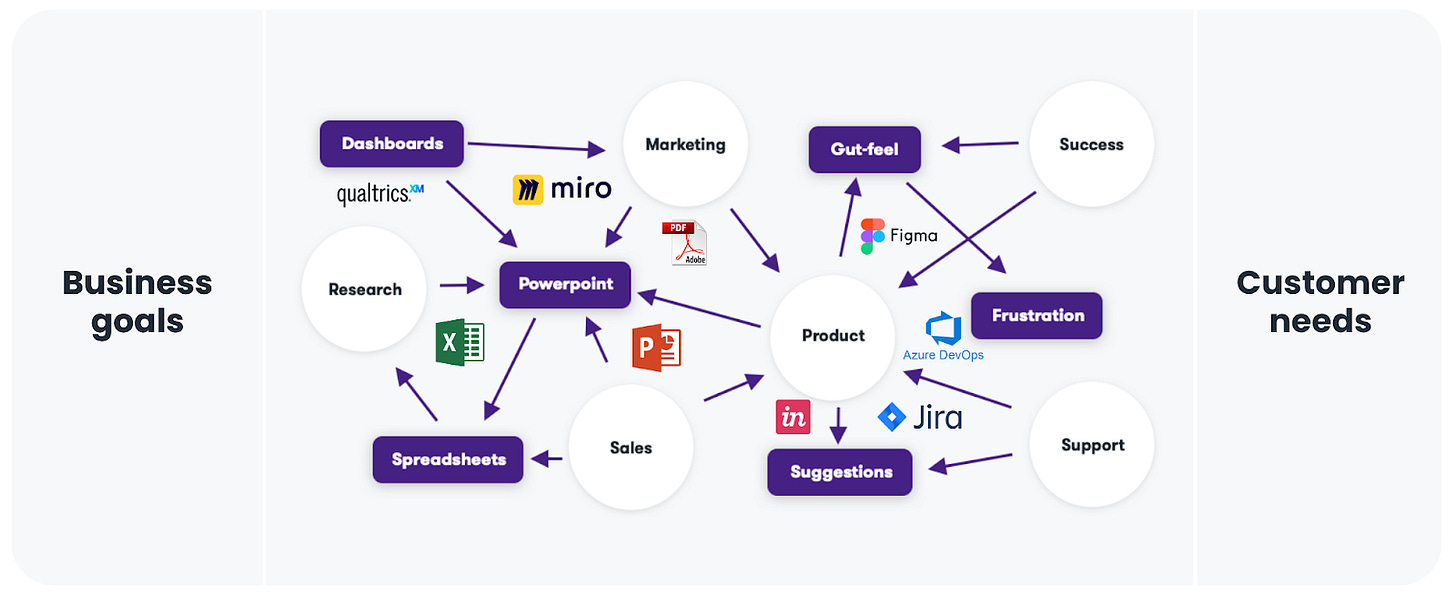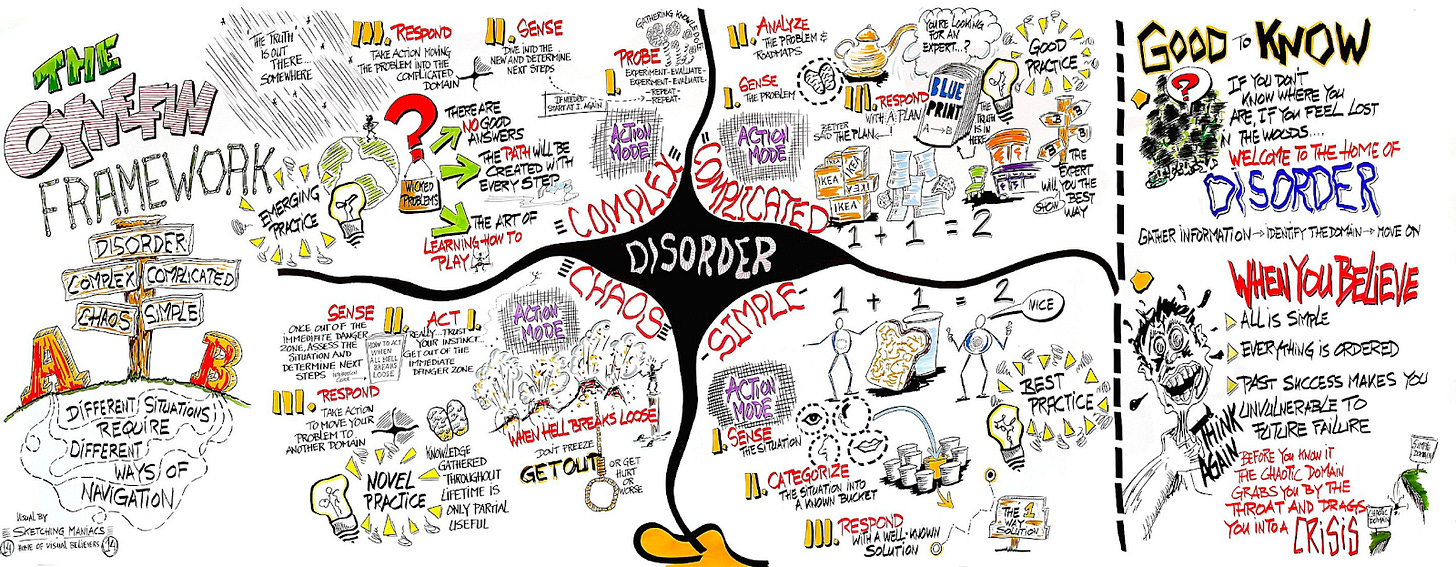Benefit #1 Journey Management provides a single source of truth for CX information
Bringing CX data into a single, accessible and up to date store breaks down silos and brings together teams. Here's how
Does your CX information have a home?
If you’re like most businesses I have worked with, the answer to this question is unclear.
When posed this question to business leaders, most often I get a pause and then a long list of documents, drives, apps, teams, people. And then the conversation moves to how hard it is to actually make use of this data.
For most companies the storage of information that includes customer insight looks something like this…
Here are some patterns for customer experience information that are way too common:
Many sources: Scattered across a variety of apps depending each teams preferences
Siloed within teams: not readily accessible across the business
Out of date: Information is not maintained over time
Atomised: Similar customer insights are created and used in isolation. They are not linked
After working in consulting for several years, these patterns are ubiquitous. This is how almost all companies organise CX information. It’s so common that it’s not even questioned as a practice.
One reason for this is the wide range of teams that have an active interest in customer insight.
Let’s contrast this with Agile
Agile and scrum, the framework for planning, managing and executing work has had an inexorable rise since the publication of the Scrum Manifesto in 2001. Over the last 22 years this approach has been incubated in start-ups, spread like wildfire to digital corporations and now is even becoming widespread in non-digital functions like purchasing, and marketing. This has been a meteoric rise for a framework so concise that fits onto 2 sides of A4.
Go into any corporation in 2023 and you will invariably find evidence of agile in their digital department:
Scrum masters and product owners
Planning, standups, reviews and retrospectives
Agile metrics, like burndown/burnups and roadmaps
It’s become so common, it’s just part of how corporations work in 2023.
Where is your agile data kept?
When I ask this question to a business leader, ‘Where is your agile information stored?’, I get a clear response:
Jira, Asana, Write, Trello. (Or a dozen other options)
There are many options for agile tracking software, but almost every business has a tool dedicated to this job. This is clearly and unambiguously where the agile data lives and it’s how the team organise themselves.
And it’s clear why…
Agile is useful for organising teams to solve complex problems.
The Cynevin framework, published by Dave Snowden in 1999, give a useful description of different types of work and the different approaches that make sense for each.
Agile software development deals with complex work, shown up in the top left.
Features that define complex work are:
Wicked problems: there are no right or wrong answers, only hundreds of options that comparably better or worse.
Emerging practice: The path to a solution is defined by each step taken to the solution. So it’s important to reflect on each step to decide how to proceed.
The best approach is Iterative:
Agile provides a framework that allows teams to navigate these complex problems.
And due to this complexity, there is a lot of data created by an agile team.
Tickets, Work outcomes, Definitions of done, Test plans, Technical approaches, Test outcomes, Time estimations, Milestones, Team performance metrics, Retrospective insights, Risks… and many more
Now, Imagine this situation in your business:
Each team uses a different app for their agile data
The agile information is often out of date - we don’t maintain it
We do not link agile data across teams
It would be chaos! This would make software development very difficult to manage.
So here's the crazy thing...
That's exactly how CX information is currently managed in most companies!
Customer experience work is also complex.
It needs an iterative, sense and respond approach.
And again, there is tons of data created:
Journey maps, personas, service blueprints, interviews, questionnaires, app insight data, experimental analysis, A/B testing, prototypes, market analysis, playback decks, planning documents… and many more
This information is stored all over the place.
There are a small number of apps moving into the CX work management space. The market leader is Theydo.
This app was created in 2019 by a service design agency that struggled with this exact problem. They created the app for themselves, to streamline their work, and soon found that their clients were keen to use the app too.
The company recently secured series A venture funding with notable backers including John Cutler from Amplitude as well as senior angels from Miro, Figma, Snowflake and Calendly.
The company is expanding rapidly into the CX work management market, which is estimated to grow to over $40Bn over the next decade.
TheyDo the best app I’ve seen for CX work management, and actually the only app right now that allows me to harness the power of CX and organise teams around this.
Key features of Theydo
Basically Theydo allows you to create personas, journey maps and service blueprints.
And you can overlay key product information like insights, pains, opportunities, solutions and metrics.
And with this information Theydo allows you to:
Links everything together: Which creates a holistic understanding of the customer experience.
Cross-team collaboration: No silos, just everyone working together in real-time to map their innovations against journeys.
Track impact across teams: Prioritise and view impact holistically across the whole organisation.
Summary
A real-time, single source of truth:
provides access to CX information across your business
Breaks down silos between teams
Provides a a collaboration space where teams can keep this information up to date and relevant
A real-time source of truth for CX information is a foundational aspect of Journey Management. This supports a range of other benefits.
More articles and videos on Journey Management
Understand Journey Management in 8 minutes
A short video that explains the fundamentals of Journey Management and how this is revolutionising innovation. (If you’re new to Journey Management, start here.)
The benefits of Journey Management (Series)
Learn more about the business benefits of Journey Management in this series. (Useful for digital leaders explaining Journey Management to their organisation.)
About me
My name is Simon Conway, A Journey Management Consultant: I help digital leaders succeed with Journey Management. I provide:
Education: For teams new to journey management
Pilot development: For CX and Product leaders making a case for Journey Management and win buy-in for
Scaling and transformation design: For Digital Leaders looking to embed journey management across your business
Coaching: 1:1 tailored support, helping digital leaders to succeed with Journey Management
Learn more and connect
View more articles on Journey Management
View my portfolio, to see how I help organisations to succeed with Journey Management









